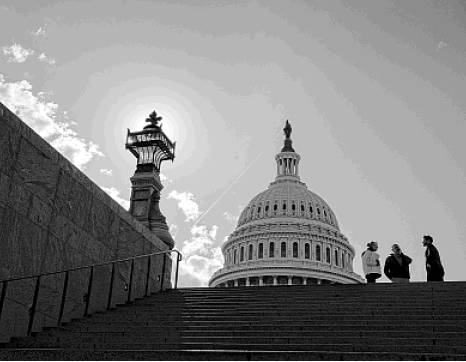Americans owe more than what appears on tax forms
CHRIS TOMLINSON Commentary
Every year our tax returns remind us how much we pay for the federal government, but the sad part is that our tax bill is only apartial payment as our national debt keeps rising.
Every business owner who keeps a ledger, and every homemaker who drafts a budget, knows this cannot go on forever. But none of our elected officials — from either party — seem willing to do anything.
Instead, President Donald Trump and Congress members from both parties have boosted government spending and slashed tax revenues, adding a record $1 trillion a year to the national debt beginning in 2020, according to the Congressional Budget Office.
The federal debt will rise from $21 trillion to $38 trillion in 2028, even with the exceedingly optimistic forecast of 3.3 percent GDP growth, the CBO reported last week. The CBO, it's worth noting, is consistently despised by whoever is in the ruling party, and loved by the opposition party, because it is not afraid to call out cooked books.
Continuing to add debt at this new, record-setting pace is unsustainable. If unchecked, the federal debt alone will equal 96 percent of gross domestic product in 2028. And that doesn't count state and local debt, which is also growing.
When the government borrows money, it leaves less cash for the private sector to borrow. The result is a higher cost of capital for companies looking to expand, slowing economic growth.
Until Americans stop buying imported goods and start saving, the national debt will grow.
Economic growth is currently strong, but inflation is also gaining steam, which means the Federal Reserve will likely raise interest rates this year. If economists ran the government, this is when the government would pay down debt, but because politicians run things, they are borrowing more than ever.
Sadly, budget deficits are a bipartisan problem, and only a bipartisan effort can solve them.
The last time the federal government collected more than it spent was in 1999 after President Bill Clinton and Democrats had passed a tax increase on the wealthy in 1994, Republicans in Congress cut spending in 1996, and the economy accelerated.
The only three budgets since 1970 that paid down the federal debt, by the way, were passed by a Republican-controlled Congress and signed by Clinton.
Today, neither Republicans nor Democrats in Congress want to cut spending. In fact, the budget passed last month dramatically increased federal spending to $1.3 trillion. That's after Trump insisted on signing historic tax cuts in December that slashed government revenues by $1.3 trillion over 10 years.
After carefully running the numbers, the CBO concluded that despite Republican promises that this recklessness will stimulate the economy, the United States will have to borrow more. Most likely, from foreign entities.
That's ironic since many economists believe that our need to borrow money underlies our global trade deficit, which is one of Trump's top priorities.
Researchers call it the Twin Deficit Hypothesis. When the government cuts taxes, borrows money and spends it, the splash of cash stimulates the economy and encourages private spending. Consumers and businesses, feeling good about the economy, spend more. The savings rate goes down, and consumers buy more imported goods.
The personal savings rate calculated by the St. Louis Federal Reserve has been dropping since November 2015 and was only 2.4 percent in December, after averaging well above 6 percent since 1960. U.S. corporate debt had hit $8.8 trillion, the highest level relative to GDP since the financial crisis when the record was set.
Trump can blame foreign manufacturers for the trade deficit, but until Americans stop buying imported goods and start saving money, the trade deficit and national debt will grow. And it all begins with profligate government borrowing.
Among industrialized countries, the U.S. is already one of the most indebted in the world when compared with GDP. Our current trajectory will make us number one.
Forty-three percent of all this borrowed money comes from overseas. Japan and China each hold about $1 trillion of our debt, presenting a national security threat far more significant than the trade deficit.
The Tax Foundation reports that the average Texan works from Jan. 1 to April 14 merely to pay taxes, which means beginning Sunday, Texans are working for themselves. But according to the National Debt Clock, federal revenue per taxpayer is $27,433, while the debt per taxpayer is $174,189.
That suggests paying off our share of the federal debt would take almost 16 months of our income.
Our elected officials, from both parties, are running up debt rather than forcing us to make tough decisions about either paying more taxes or slashing government spending.
Line 63 on your Form 1040 may read “Total Tax,” but that's just another lie.
Chris Tomlinson is the Chronicle’s business columnist.chris.tomlinson@chron.com twitter.com/cltomlinson

